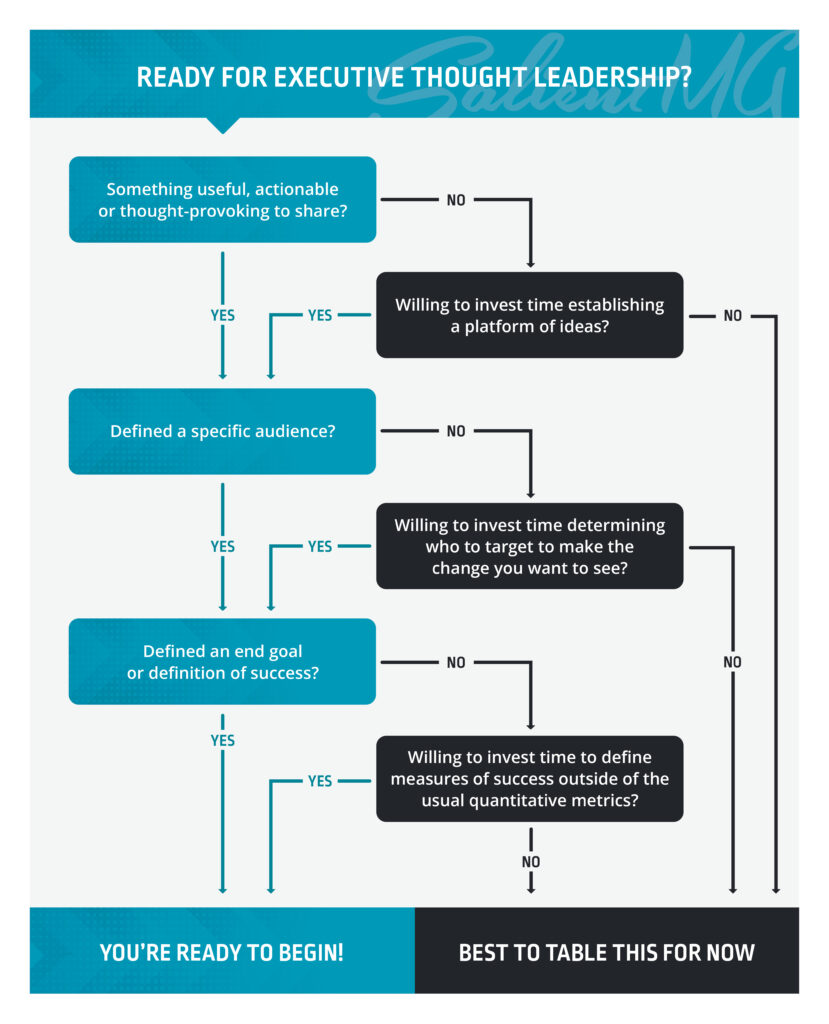There’s nothing worse than signing up for a program without knowing the rules, the expectations and how much it’s going to cost. (And “cost” could mean dollars, time, energy or all of the above.) Before embarking on a thought leadership program initiative, make sure you’re ready to invest what it takes to get the return you expect.
Like any other initiative, thought leadership requires research, resources and a strategy. We’ve touched on the dos and don’ts of thought leadership and corporate thought leadership versus executive thought leadership in previous posts. Once you’ve done your due diligence, however, it comes down to a bit of final reflection and decision making.

- Do you have something useful to say? As an entrepreneur/founder/executive you undoubtedly have a multitude of experiences and creative approaches to overcoming challenges. But do you have a core set of ideas you want to double-down on or a rich vein of ideas that’s sustainable to mine for the long-term? Making it up as you go along is different than having spontaneous thoughts but just missing the time or words to communicate them. There should be a solid strategy in place with your topics–whether they’re mapped out for months at a time or occur to you in the spur of the moment–so they roll up to a platform that’s recognizable as you.
- Do you have a specific audience in mind? As much as we’d like to think our words and thoughts have the broadest possible appeal, “everyone” is not a target audience. Who, specifically, needs to hear your message in order to enact the change you want to see? It doesn’t have to be a formal process, but you should have a persona in mind for the ideal consumer of the content you’re producing. Not only does that help you refine your thinking but it helps define the outlets that are going to be most receptive to and most helpful for disseminating your message.
- Do you have a defined goal? Thought leadership requires dedication. It’s a long game and may at times feel repetitive, but without commitment and consistency you won’t build the audience and the momentum you need to take off. Which means you need to set a target for yourself. As you reach different milestones, that target can evolve to keep you motivated, but without something to strive for and reasons to celebrate along the way, it becomes too easy for your thought leadership efforts to falter and any progress or gains you’ve made to backslide.
- Do you have the patience to do this? It’s important to be honest with yourself here, for the sake of respecting your own time and energy as well as that of any internal or external partners helping you with your thought leadership efforts. If you’re going to be easily distracted by other projects, already have too many other time commitments on your calendar or value the quick wins over things that may take several weeks to manifest, think about a) what you’re willing to shift to make this a priority or b) if your energy is better spent in other areas.
The goal here is not to dissuade you from pursuing executive thought leadership. On the contrary, it’s to help frame executive thought leadership the way it should be viewed: as a reflection of you as a professional, as a leader, as a role model. People follow when there’s a plan, a path and a purpose. When you can deliver on those, you’re setting yourself up for success.
This post is the final in a three-part series about building your professional brand through executive thought leadership.
- Explore our first post on the Dos and Don’ts of establishing thought leadership.
- Review our second post on the difference between corporate thought leadership and executive thought leadership.
Curious to learn how SalientMG can help you define and deliver on your executive thought leadership goals?

